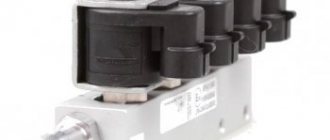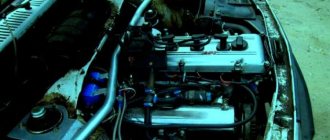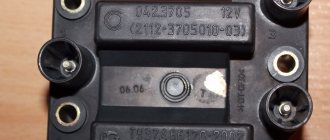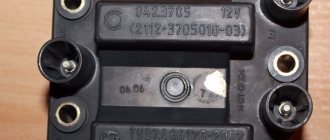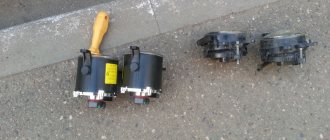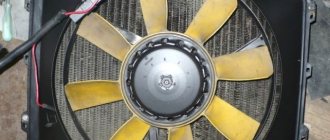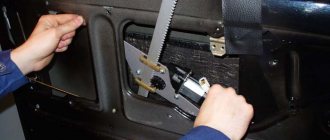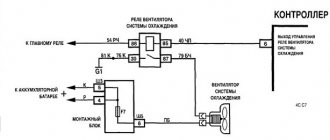Installing LPG on a car is a complex process that requires special equipment and knowledge. It includes installation of the tank, gearbox, connection of the cooling system, control unit, settings and solving other problems. It is also necessary to understand that after completion of the work, registration with the traffic police is required, without which the car owner receives a fine of 500 rubles, and in case of malicious failure, more serious consequences are possible.
Self-installation of HBO 2
It is not difficult to install gas equipment on a car yourself if you follow safety precautions and have knowledge of installing such devices.
Stages of installation of gas equipment for 2nd generation gas:
- installation of a cylinder;
- gas main wiring;
- installation of a mixer and dispenser and control unit for gas equipment;
- testing work on the tightness and performance of gas equipment.
Before starting installation, check that all gas equipment is available:
- gas cylinder (cylindrical or toroidal);
- multivalve;
- gasoline and gas electric valves;
- filling valve;
- mixer;
- control panel and wires;
- gas hoses and tubes;
- tees;
- clamps.
Description of step-by-step instructions for installing gas equipment:
- Cylindrical cylinders are mounted in trunks. In hatchbacks, a good option for installing a toroidal cylinder is in the spare tire niche. It is better to install methane on large cars, for example, Gazelle, where there is room for a bulky container.
- Fix the filling valve on a bracket under the rear bumper, on one of the rear fenders or in the trunk of the car.
- Lay the gas line from the cylinder to the engine compartment along the bottom of the body. The fuel line must not pass through the passenger compartment. The hole for the gas line outlet is made with a larger diameter than the pipeline in order to insert a protective rubber or plastic seal into it. The edges are treated with anticorrosive.
- A gas line is fixed along the bottom. You can place the gas pipeline next to the gasoline pipeline in the niche provided for this.
- The next step is to install a mixer between the carburetor and the intake manifold of the car. Tightness is achieved using O-rings and sealant to prevent air leaks. If this is not done, traction will be lost and jerks and dips will occur when the engine is loaded. Typical for the Solex carburetor, its modification DaAZ 21073–1107010 is installed on the Niva.
- The next operation is to install a gasoline electric valve in the fuel pipeline between the gasoline pump and the carburetor.
- Install the gas valve.
- The gas line is connected to the valve.
- A gas reducer is mounted next to the carburetor.
- Connect the gearbox to the pipes that lead to the car's heater. The 2nd generation Lovato gearbox performed well in Russian winter conditions.
- The line from the shut-off valve is connected to the installed gearbox.
- A gas dispenser is installed between the reducer and the mixer.
- The LPG control panel is installed in the cabin and connected.
To perform a test run of HBO, the cylinder needs to be filled with approximately 10 liters. The pipeline is blocked. A soap solution is applied to the line connections. Perform gas inlet and inspect the joints. Bubbles will appear in areas of leakage. If it is not possible to immediately eliminate the causes by tightening the clamps, the gas pipeline is shut off and the connections are redone.
Before operating the LPG, it is necessary to check the effect of the anti-pops on the injector. If the gas pressure exceeds, the firecracker will prevent the gas mixture from exploding.
If the leaks are not eliminated, the consequences of such operation of the car are increased fuel consumption, engine shutdown, gas poisoning, and even an explosion. If in doubt, it is better to set up and service the gas equipment in a specialized service center. The address of the station where gas cylinder installations are serviced can be found on the Internet.
A few words about HBO
Gas equipment installed on a car is a system that allows you to supply liquefied gas as fuel to gasoline or diesel engines.
Today, the most used are installations for two types of gases - propane-butane and methane. There are no particular differences between different types of gas equipment in terms of power supply, but methane equipment is noticeably more expensive. As a result, many motorists prefer propane units.
Depending on the configuration and optional equipment, there are 6 generations of gas equipment. Each type of equipment has its own set of components, but the improvement of systems from 1st to 6th in relation to all aspects of the use of gas equipment is invariably traced.
It is worth noting that the vast majority of motorists prefer 4th generation units, considering them the best in terms of price-quality ratio. One cannot argue with this; installation and maintenance of HBO 4 are truly the most optimal among all equipment of this kind.
At the moment, gas equipment is installed on at least a third of all cars traveling on the roads of the Russian Federation.
Considering such a demand for gas equipment, the government of our country has taken a serious approach to the legal side of its installation and operation. Thus, since 2016, it has been officially prohibited to register gas equipment that is not installed in specialized centers with appropriate accreditation.
In addition, the legalization of HBO has become mandatory for any motorist, and its periodic inspection has also been made mandatory. By the way, diagnostics of gas equipment in special maintenance centers should be carried out every 2 years for propane equipment and 5 years for methane installations.
In any case, some motorists install gas equipment with their own hands, after which they receive the corresponding papers in special centers, so to speak, by agreement.
Installation procedure for gas equipment
Let’s say you decided to install LPG on your car yourself – what will you need to do? No matter how trivial it may sound, it’s easy to install the equipment.
It is worth understanding that the installation procedure consists not only of installing the equipment on the machine, but also of observing a considerable number of nuances of this operation. The installation procedure for gas equipment is discussed in as much detail as possible below.
So, in general, the process of installing and connecting LPG is as follows:
- First, be sure to obtain permission to install gas equipment on your vehicle. Ignoring this stage will make the following installation steps a useless exercise, because to register the LPG you will have to remove the installed equipment, obtain permission and re-install it;
- Then, of course, purchase a set of gas equipment components. Judging by the reviews of owners of gas-powered cars, the best LPG systems today are 4th generation units from the manufacturers Lovato and BRC;
- Has permission been received and the installation purchased? We don’t hesitate and start installing it. Perhaps, there should not be any particular difficulties at this stage, of course, if you have at least basic car repair skills. The connection diagram for any installation is discussed in detail in the instructions supplied with it. You can connect the HBO, following the order described in the instructions, without any problems. In a typical version, installation consists of organizing the following stages:
- After installing the HBO, first of all, it is important to adjust it. Again, the instructions for the installed equipment will help you with this. The setup and diagnostics of HBO is described in more detail in the next paragraph of our article;
- Then all that remains is to officially register the equipment and begin to operate it legally.
Important! Let us repeat, installing HBO is not such a complicated procedure, requiring only compliance with some instructions. Despite this, many motorists make common mistakes in installing gas equipment, violating the correct algorithm of actions. If you are not sure that you are able to organize everything in the correct order, it is better to entrust the installation of LPG to professionals.
Setting up HBO
Having received a car with gas for use, or having installed the appropriate equipment, many motorists ask the question “How to set up LPG?” In fact, it is very simple to adjust or simply adjust an existing gas installation. Correct adjustment of the HBO takes place in the following order:
- First, make sure that your installation has a special connector for the diagnostic cable (usually located on the equipment control unit). If it is missing, install and find a cable for it;
- Then prepare the equipment for setting up the HBO yourself. This goal is also not difficult to achieve, because all you need to do is find a laptop, install a diagnostic program for your model of gas equipment on it and, again, find the previously noted cable (often it comes complete with gas equipment, but if you wish, you can make it yourself or purchase );
- After this, the HBO diagnostics itself begins. This is done by connecting diagnostic equipment to the gas equipment control unit through the appropriate connector. In general, tuning of HBO 4th generation and higher is carried out according to the indicators recommended by the manufacturer. In the diagnostic mode, any motorist will be able to identify violations in the operation of certain elements of equipment.
In fact, it is in the manner described above that the SSS of any formation is controlled, since this approach allows:
- configure all possible components of the equipment if necessary (for example, when changing the configuration of the car);
- identify breakdowns of gas equipment;
- monitor the presence of incorrect operation of certain components of the gas installation.
Often, diagnosing HBO does not cause any particular difficulties for motorists, since the procedure is carried out in a simple manner. We hope your case will not be an exception here.
Possible faults
After installing the equipment or during its use, motorists often need to repair the gas equipment.
In most cases, repair work is required due to problems in the operation of the engine when switching to gas or the appearance of pronounced disturbances in the operation of the gas equipment itself.
In order to clearly show the main malfunctions of gas equipment to our readers, we present the following list of breakdowns for consideration:
- Unstable operation of the engine on gas or its complete failure. The range of possible problems here is very wide. In principle, absolutely any element of the gas equipment can be faulty. Note that if the latter was installed recently, then to begin with it will be enough just to check the correct installation of all components of the equipment. Otherwise, don’t be too lazy to diagnose the entire gas equipment, purify, adjust and, if necessary, repair the equipment. You may need to purchase a repair kit;
- Problems in the operation of the evaporator gearbox (the car refuses to run on gas or does it extremely poorly, there is instability in idle speed). All you need to do here is to set up the gas equipment correctly, check the tightness of the unit, drain the condensate from it and clean it thoroughly. If these operations do not produce any effect, the situation can be corrected by using a repair kit. Naturally, all faults found must be eliminated;
- The LPG filters are clogged and need to be changed every 10,000-20,000 kilometers (symptoms are similar to those that occur with problems with the gearbox). To repair such a malfunction, a repair kit is not required; it is enough to purchase filters and replace them;
- Popping noises appeared in the intake manifold. Here it is important to diagnose HBO using special equipment. In most cases, it helps to identify the presence of a particular problem. By the way, the essence of the claps may lie in both air leaks and incorrect settings of the gas equipment;
- Gas leak (there is a smell in the cabin). In the event of such a breakdown, it is necessary to immediately diagnose the equipment, identify the location of the leak and seal it. It is better to stock up on several repair kits in advance;
- The metering nozzles are clogged or faulty (the engine is unstable at all speeds or refuses to function at all). This problem is always identified through diagnostics and requires either cleaning or replacing the dispensers, nothing else.
Features of the operation of 4th generation gas equipment
The equipment allows for combined power supply of the engine with gasoline and gas. Switching from one power mode to another can be done from the cabin manually, as well as automatically. The small control panel contains an LED gas level indicator and a fuel switch. The usual location of the control panel is under the steering column on the left near the headlight adjustment control.
The gas indicator contains four green LEDs and one red, located in one row. When one green LED lights up, it indicates the presence of 10 liters of gas. Usually this reserve is enough for 100-120 km. The red LED lights up to indicate the presence of emergency fuel remaining, which may be enough for 50-80 km. It warns you about the need to refill gas at a gas filling station.
A separate red LED, located in the upper corner of the remote control and operating in a flashing mode, signals that the engine is currently running on gasoline, but the system is preparing to switch to gas fuel. This happens every time the engine is started until it reaches normal temperature and warms up well.
Button for switching engine power mode and gas quantity indicators
Since the engine has both a gasoline and gas power supply system, such duplication doubles the reliability of its operation. In addition, the mileage on one refueling with gasoline and gas fuel increases significantly. This is beneficial on long trips through sparsely populated areas, where the network of gas stations is sparse and of poor quality. Also adding the ability to increase protection against car theft is an easily removed and installed switch, the removal of which blocks the supply of gasoline and gas to the injectors.
The 4th generation LPG is especially beneficial for car owners whose engines are equipped with an expensive fuel injection system with a catalyst for purifying exhaust gases. It not only provides significant savings on expensive high-octane AI-98 fuel, but also saves the life of the catalytic converter. This equipment is intended for vehicles that meet environmental requirements Euro-3 and higher. It has a pulsed gas-air mixture injection system, which operates under the control of a separate control unit interfaced with a microprocessor. The control unit processes microprocessor commands and generates control signals that open the electromagnetic gas injection injectors and block the gasoline mixture supply injectors.
The concentration of the supplied fuel mixture is controlled by a system of sensors that determine:
- gas pressure;
- reducer temperature;
- gas temperature.
If the supply gas pressure drops below a threshold value, the electronic unit automatically turns off the gas injectors and opens the gasoline injectors, switching the engine to gasoline power.
Principle of operation
The 4th generation gas installation operates on this principle.
The electronic control unit is connected to the wiring between the standard fuel system control unit and the gasoline injectors.
The signal coming from the block to the injectors is read by the gas system control unit and, based on this signal, the amount of gas required to be supplied to the cylinder at a given moment is calculated.
After this, the signal is transmitted to the gas train. The gas in it is constantly under a certain pressure, which it received from the gas reducer.
The signal received at the ramp causes the valve to open using an electromagnetic injector, and gas enters the intake manifold.
This signal will also close the injector valve, which ensures high accuracy of fuel supply.
As a result, it turns out that the fuel system is controlled by a standard electronic control unit based on lambda control sensors.
The gas equipment control unit only converts the signal from the standard unit to the requirements that are necessary for the normal operation of the gas power plant.
This is the peculiarity of the 4th generation HBO.
Pros and cons of HBO OMVL
Among the arguments in favor of OMVL gas equipment for 4th generation cars are reviews from motorists who have encountered its operation in Russian conditions, where the nearest service center may be several dozen kilometers away.
And also simple facts. Firstly, according to statistics, such units are chosen in more than 40 countries. In Russia alone this is about 20 thousand assembled kits. Secondly, more than 50% of the total supply volume goes to factories, for the installation of turnkey gas equipment, for new cars under the brands: Toyota, Hynday, FAW, Volkswagen, BYD, Suzuki, Tata, Ford, GAZ, and this list is constantly expanding. Thirdly, on the 4th generation OMVL HBO, the connection diagram is one of the most thoughtful: there is not a single extra detail or random element in it.
Finally, the Gorky Automobile Plant has been using equipment of this brand for more than 5 years to re-equip its products. And this is a solid recommendation. The disadvantages include pickiness in the degree of fuel purification (an eternal disease of all systems), an abundance of electronics, expensive maintenance (and only in authorized workshops), as well as the tendency of the distribution unit to fail.
And then a problem arises called: “OMVL gas reducer 4th generation, repair”, and its cost is a round sum
There is only one way out: do not delay maintenance, change small failed components in a timely manner and pay attention to any malfunctions in the engine. If these conditions are met, the installation will last a long time and be virtually trouble-free.
Installing a gas-cylinder unit in a car in the current economic conditions is completely justified: propane is several times cheaper than gasoline, and this fuel is more environmentally friendly. The steadily growing reliability of the alternative fuel supply system is also an argument in favor of switching to liquefied gas.
You might be interested >> Gas equipment Lovato malfunctions and solutions
Electronic injection and mixture supply, the ability to fine-tune engine operating modes open up new prospects for the owner: not only to reduce refueling costs, but also to maintain the vehicle’s speed characteristics unchanged.
A remarkable solution from all points of view would be the choice of 4th generation HBO, OMVL, a brand that has proven itself in the best possible way. The company, with more than 30 years of experience in designing gas installations for transport, is among the leading manufacturers, and the quality of Italian factories has always been rated as high, especially when it comes to automotive equipment.
What is needed for proper installation
To properly install gas equipment on a car, you will need a certain set of equipment and tools:
- HBO set 4;
- gas hoses with clamps 60-80cm long, Ø4-5mm and Ø12mm 50-100cm (for a 4-cylinder engine); 40-70cm vacuum tube Ø6mm; a cooling system hose with two metal tees corresponding to the size of the inlet/outlet on the gearbox - the length of all lines is selected individually for the car;
- thermoplastic gas tube of the required length (you can use copper or aluminum);
- auto tools;
- drill and/or screwdriver;
- drills (Ø4.8mm, crown 30mm);
- tap 6mm;
- electrical tape, heat shrink tube, hair dryer;
- soldering iron (materials for soldering wiring);
- multimeter;
- metal clamps/brackets with self-tapping screws (for fastening lines under the bottom);
- a can of anti-corrosion treatment or auto enamel;
- engine intake manifold gasket.
You will also need a lift/overpass or inspection hole.
Mass air flow sensor device
The internal structure of the sensor is a fine mesh, in the middle of which a platinum thread is stretched. The latter warms up to a temperature of about 700 degrees in a short time. When air passes through it, the thread cools slightly. By how many degrees the filament temperature has dropped in comparison with the reference value, the amount of air passing near it is measured. The output value varies in the range from 0 to 5 Volts. If there is no air flow and the engine is turned off, then the output of the mass flow sensor will be exactly 1 Volt. If you start the engine, air will begin to flow through the mass air flow sensor. The higher its consumption, the greater the voltage will be at the output of the sensor.
Setting up HBO yourself
Let us immediately note that if installing an LPG taking into account the instructions is a complex but feasible task, setting up an LPG assumes that there is a clear understanding of why this or that action is being performed. In other words, for example, setting up a 4th generation Digitronic HBO with your own hands or setting up any other system can rightfully be considered a complex and responsible task.
It is important to understand that errors in settings can lead to unstable operation of the internal combustion engine, various malfunctions and even failure of the power plant and individual vehicle systems
Please note that if you are not confident in your abilities, it is better to immediately entrust this procedure to an experienced master. If you want to configure the HBO yourself, you will need to buy a special wire (cable) and also install the appropriate software on your laptop
By the way, all systems are similar to each other, that is, for example, setting up a 4th generation Lovato LPG with your own hands will not differ much from similar settings in other systems. The only difference is in the graphical interface of the programs themselves and some options that are needed for advanced configuration.
So, before starting the setup, you need to warm up the car until the engine reaches operating temperatures. Next, you need to remove all load from the internal combustion engine, except for idling (turn off the heater, headlights, dimensions, additional equipment, etc.). Now you can connect with a cable and run the unit setup program. Let's look at the HBO tincture, using the STAG4 program as an example.
First, in the program window, you need to set the number of engine cylinders per coil; the RPM speed must also match the engine speed (550-940). All data must exactly match the vehicle.
After this, you need to go to the tab where the switch-on temperature is set. For summer not lower than +35, and for winter not less than +40. Cylinder shutdown is set to 250. This will allow for a smooth transition from gasoline to gas and back, without engine vibration.
As for pressure error time, this parameter is set at 300 to 420. When choosing the type of gas injectors, it is important that the selected type is exactly the same as those on the machine. If the owner does not know which injectors are installed, the injectors need to be inspected
Manufacturers usually mark them so that the program can then determine which injectors are installed.
The operating pressure of the gearbox should be from 1.0 to 1.3 bar, the minimum is not less than 0.50. Fuel type LPG for propane or CNG for methane (marked). Now you can go to the automatic configuration tab and click start (start). All you have to do is wait from 1 minute to 5 minutes. The setup time depends on how well the car runs on gasoline. If the engine is not running stably, there are problems with the ignition system, etc., then it will take more time for auto-tuning.
Next you need to go to the map tab. There you can see that the orange line has taken a bend
So, it is important to note from which number in the coefficient section the line begins. It is good if the line lies in the range of numbers from 1 to 1.4. The fact is that when installing LPG, a specialist must select the right injectors for performance, taking into account the power of the car’s engine
The fact is that some injectors can be adjusted to the engine, since they have a performance margin, while others are designed for a specific power and the margin is minimal
In any case, the pressure of the reducer is important for all types of injectors. During auto-tuning, the program itself will calibrate the pressure of the reducer, and the line may become higher than a coefficient from 1 to 1.4 or lower than this indicator
In the first case, overestimation indicates that the pressure is from 1 to 1.3 bar, but the injector nozzles are too narrow. This suggests that it is possible to increase the performance of the injectors by drilling out the nozzles and making them wider, which will increase the throughput.
If the line is below the coefficient, this indicates large nozzles. In this case, the throughput of the nozzles is reduced by changing the nozzles to suitable analogues with a smaller diameter. Note that the line at a pressure of 1-1.3 should normally be in the range of the coefficient 1-1.4. With such indicators, throttle response is maintained, gas consumption does not exceed 20% compared to gasoline, and the engine operates under normal conditions, there is no big risk of reducing its service life.
HBO button connection diagram
Let's look at the connection diagram for the 2nd generation HBO button for an injection-driven internal combustion engine using the example of a product from the manufacturer stag2 and Digitronic.
It should be noted right away that the basic functionality and connection method itself are the same for almost all manufacturers. The recommended connection diagram must necessarily be included with the HBO switch. The connection diagram for the 2nd generation HBO button to the carburetor will have a similar appearance.
The wire set for stag2 and Digitronic products has the following colors:
- White. It is connected to the gas level sensor in the cylinder and is responsible for the correct indication on the fuel level button in the cylinder.
- Cyan (blue). It is connected to the electromagnetic gas valve, which is located on the reducer. When the device is switched to the “Gas” operating mode, the gas valve opens and gas is supplied to the reducer. An additional gas valve with a filter and an injector emulator can be connected in parallel to the same wire.
- Yellow. Connects to the solenoid valve in front of the gasoline pump. When the button is in the “gasoline” position, power is supplied to the gasoline solenoid valve and the car runs on its native fuel. When the car switches to the “gas” operating mode, no power is supplied and the fuel pump does not work. Many installers of gas equipment do not recommend turning off the gas pump, but insist that it works even when the vehicle is running on gas.
- Red . Power supply for the HBO button. You can connect directly to the positive terminal of the battery through the fuse and boot for it included in the kit. In this case, the HBO switch will be under constant voltage. If you want to power the gas-gasoline switch only when the ignition is turned on, you should take 12 volts from another place (for example, power supply to gasoline injectors).
- Black. Ground, needs to be connected to the car body.
- Brown . Connects to the control contact on the ignition coil. From here, information about the number of engine revolutions is taken and, accordingly, gas-gasoline operation is automatically switched. In the case of a carburetor engine, a signal is taken from here whether the engine is running or not; if the engine is turned off, no fuel is supplied.
Today we will talk about 4th generation LPG, design features, principle of operation, advantages over earlier generations of LPG, installation procedure on carburetor and injection cars, whether it is better to use propane or butane. So, let's go.
Converting a car to use gas as the main fuel is becoming increasingly important in the context of ever-increasing gasoline prices.
This equipment allows you to operate on cheaper fuel, without much intervention in the design of the car.
With the improvement of the car design, as well as with the tightening of toxicity standards introduced in Europe, which are designated as Euro, gas equipment was also modernized.
If the 1st generation gas equipment was very simple in design, without the use of electronics, then the 4th generation gas equipment is already a complex electronic-mechanical device, although the essence of their work is the same - supplying gas to the engine cylinders under certain conditions.
But in the first generation, gas was supplied due to the vacuum created in the engine cylinders, and there was no talk of precise dosage of fuel under different operating modes of the power plant.
How to install gas equipment on a car? 8 practical tips
LPG or gas equipment is a device that is installed on a car and allows the use of gas as fuel.
The use of gas equipment in a car allows you to reduce gasoline costs and increase engine life, reduce repairs, and also reduce the amount of harmful emissions. With daily movements in the area of 100 km, installing gas equipment on a car pays off within 3 - 4 months.
Main components and gas equipment
The HBO system includes mechanical and electronic devices. It includes:
A cylinder equipped with a multivalve - a device that consists of several mini-devices. It contains: a gas level indicator, two valves - for filling with gas and for its flow. The balloon can have different shapes, most often cylindrical and toroidal.
The shape and dimensions of the cylinder are chosen so as to optimally occupy the space inside the car: in the trunk, spare wheel or under the bottom. The multivalve on the top of the cylinder is closed with a ventilation box, which prevents possible gas leakage.
It is connected to the outside of the car by tubes that remove gas in the event of an emergency leak. Cylinders can be:
- steel;
- made of alloy steel with a plastic (composite) cover;
- aluminum with plastic cover;
- completely composite.
The cylinder is located at the rear of the machine and is connected to the LPG system by a pipe called a line. All other elements of the system are located under the hood of the car:
- Control unit (electronic controller) - controls the operation of the entire gas equipment.
- Gas valve - installed on the gas flow line (pipe). It has a fuel purification filter and is controlled electronically.
- The reducer is a chamber for evaporating liquid gas. To evaporate, the reducer reduces the gas pressure from 16 atm to normal atmospheric pressure (1 atm) and heats it up. The gearbox can be electronically controlled or mechanical. In the first HBO systems, reducers injected gas when the pressure inside the mixer decreased, and therefore were called “vacuum”. In some gas treatment systems, reducers are used additionally - they are connected to the cooling system, since the process of gas evaporation takes away heat and cools the reducer. The reducer builds up gas pressure and injects it into the mixer.
- A mixer or manifold is a chamber into which gas and air are supplied in certain proportions. Next, the prepared mixture enters the combustion chamber.
- Gasoline valve (this element is present in GBO-1 for carburetor engines) - stops the supply of gasoline.
- Sensor-controllers for pressure and gas temperature.
Also included in the LPG system is a fuel type switch . It is placed in the salon. With its help, the positions of the gas and gasoline valves are changed, switching the type of fuel. This can be done at any time: idling or while the car is moving.
Operating principle of HBO
Gas equipment on cars operates on various forms of gas: liquefied and gaseous. Most often, liquefied gas is used for work - a propane-butane mixture. Less commonly, compressed natural gas (methane). There are few methane gas stations, so compressed gas cylinders are not popular.
How does the HBO system work? Gas flows from the cylinder through the filter to the reducer. Since it is under pressure in the cylinder (about 16 atm), it moves through the pipe by gravity. Once in the reducer, the liquefied gas is converted into steam and evaporates. To do this, the reducer reduces its pressure and heats it up. While the engine is running, heat from the engine is used to heat the liquid gas.
Multivalves Lovato
Lovato 4th generation for those who value quality and save money
The modern line of multivalves consists of two classes:
- Euro class (type 305);
- Class 00 (type 318).
Euro class (type 305) is the multivalve that should be on the gas cylinder of your car. This class of Lovato multivalves is equipped with all necessary (according to the requirements of the Technical Regulations of the Customs Union) safety elements and service functions:
- Technology of filling no more than 80% of the cylinder volume (reserve for thermal expansion of propane);
- An electromagnetic valve that blocks the flow of gas when driving on gasoline, while stopping the engine, or turning off the car's power;
- Fire damper;
- Overpressure relief valve;
- Gas level sensor in the cylinder;
- Manual valve for shutting off the gas flow;
- Emergency valve for gas line break.
In the line of Euro-class Lovato multivalves, you can easily find a device specifically for your gas cylinder, and it does not matter whether it is cylindrical or toroidal, whether it has an external or internal neck (what types of gas cylinders there are are described here). Class 00 (type 318) is a simplified version that lacks some devices: solenoid valve, fire damper. Class 00 (type 318) is a simplified version that lacks some devices: solenoid valve, fire damper
Class 00 (type 318) is a simplified version that lacks some devices: solenoid valve, fire damper.
What to choose: propane or methane?
The fourth generation gas equipment can operate on methane or propane-butane. But the design of such gas-cylinder equipment will be somewhat different. Methane has a higher pressure, so the cylinders are appropriate. Be sure to install a filter to remove impurities on the gas line.
The gas line must be designed for high pressure applications. The gas reducer for a methane-powered car has two sections for gradually reducing the gas pressure to the required value. The rest of the GBO design is the same.
The disadvantage of methane is the large weight of the container, and this is not always applicable to passenger cars. There are much fewer refills for methane systems. However, such gas is cheaper, and it is advisable to use it in commercial vehicles.
LPG for propane-butane is much smaller in size and weight, since this gas is liquefied. Therefore, car owners choose it. The LPG reducer for propane has only one section. The gas is purified from impurities using a filter included in the circuit immediately after the gas reducer.
Some tips for installing HBO
Firstly, you should only be interested in installing 4th generation HBO. Currently, some services already offer fifth-generation equipment, but we do not recommend buying it. The fact is that it already implements a method of supplying liquefied gas directly into the combustion chamber. Considering the average purity characteristics of our fuel (yes, everything is not so good here), you will spend a lot of money on maintenance.
Secondly, it is better to run plastic rather than copper gas lines from the cylinder to the engine. The point, again, is the low purity of domestic fuel. Copper begins to quickly oxidize and become unusable, while plastic can withstand the presence of almost any impurities without any problems.
Be sure to supervise the work of the installers: gas pipes are intended only (!) for gas, and for the cooling system - only for antifreeze. Under no circumstances should they be swapped!
The fittings should be cut into the manifold only after removing it. Unless you completely control the process, it is virtually impossible to prevent metal shavings and other debris from entering the engine, which can cause a lot of trouble in the future.
Pros and cons
In conclusion, we will highlight the advantages and disadvantages of installing gas equipment on a car. Advantages:
- saving on fuel;
- less engine wear, and the influence of gas equipment on a car is greatly exaggerated;
- longer autonomous mileage;
- environmentally friendly exhaust;
- increasing the service life of a car engine.
Minuses:
- additional expenses for maintenance of the gas installation of the car;
- reduction of free space in the trunk;
- large installation costs, even with subsidies;
- reduction in engine power;
- if something is done wrong, problems will arise almost immediately (in the best case, the car will stop starting after installation, in the worst - total).
In the comments, share your experience of installing a gas cylinder system on a car and the difficulties that arose.
Rough adjustment for load. Peculiarities
When this option is selected, it is customary to change the cells; this is done not by revolutions, but solely by injection time. All that is required is to remember the fuel injection time, this is done at certain points in the movement, after which you need to switch to gas. This is how the 4th generation gas equipment is configured, the nozzles are adjusted and the work in general occurs. In addition, the 4th generation HBO, namely the pressure adjustment of the reducer, plays an equally important role.
Attention: Every driver must understand that adjustment of the LPG gearbox, as a rule, is required only at the time of installation of the unit. But after one hundred thousand kilometers, it is necessary to perform diagnostics
It is also possible to service 4th generation gas equipment with your own hands, but only if you have the appropriate experience, knowledge, and equipment that allows you to do this.
If you consult with specialists, you can find out how to remove 4th generation HBO with your own hands, doing it at home. You always need to know that the proper operation of the unit does not depend on the quality of the electronic settings, as for some reason most car owners believe. Indeed, after a certain period of operation, valves and membranes begin to wear out, resulting in excessive gas consumption.
But this unpleasant moment can be delayed if you learn about the intricacies of proper operation of the equipment. For example, as for starting the engine, this should always happen exclusively on the car’s native fuel, which is often forgotten. Only at the moment when the engine temperature reaches thirty degrees can you switch to gas.
This is explained by the fact that the gearbox membrane freezes in practice at low temperatures. Therefore, the gearbox must be connected to the antifreeze lines, and only this way. If you want to configure the 4th generation LPG gearbox yourself, you need to realize in advance that this is not as easy to do as it seems.
Before doing such work, do not forget to warm up the engine, after which you can turn off the gasoline supply. If there is a need to adjust the sensitivity of the gearbox, then you need to unscrew the sensitivity regulator, and the procedure is performed at the moment until the idle speed values change.
Next you need to tighten the regulator and check the setting. All you need to do is press the accelerator pedal - the engine should not react to such an action, and accordingly, you should notice the absence of delays and jerks. Of course, if you managed to configure the 4th generation LPG yourself, and you did everything correctly, then the internal combustion engine will work stably and accurately.
Is it worth installing it yourself?
Many car owners ask how to install LPG on a car with their own hands. The installation process is difficult and requires utmost attention. Any mistake may result in leakage, damage and subsequent explosion. That is why, if you lack experience, it is better to entrust the work to specialists.
Note that the technical part of installing an LPG on a car with your own hands is still possible, but the main difficulties arise when connecting the electrical part and setting up the equipment using a laptop. This type of work will certainly require special experience.
Controller Features and Functionality
The production of an electronic control unit for gas systems is established in Polsky, whose products have long proven themselves in the gas equipment market.
The device was developed on a 32-bit high-performance processor, has a compact design, assembled in a sealed plastic case, convenient for installation.
Main features of Digitronic Maxi 2/Titan:
- compatible with methane/propane gas equipment
- designed for engines up to 4 cylinders, with distributed fuel supply (paired, phased, asynchronous)
- building a 2D map based on injection time
- work in conjunction with a parameter recorder and an oscilloscope
- Suitable for turbocharged internal combustion engines, also with Valvatronic system
- there is an adjustment for t° and gas pressure
- work with heating of gas injectors
- adjusting the number of emergency starts with sound alarm
- a start-stop system is available (compatible with hybrid power plants, a warmed-up engine starts immediately on gas)
- automatic adjustment of fuel level sensor
- tests components (gas valve, buzzer, injectors, LED alarm), reads and records system errors
- automatic calibration
- reading engine speed from gasoline injector signals
- setup via bluetooth connection
- adaptation to work with the main types of gas injectors
- possibility of setting a lock with a PIN code (after the programmed time has elapsed, the machine will stop switching to gas)
- records the parameters of the machine and gas equipment with subsequent information about the maintenance of gas equipment
According to the manufacturer's plant, the electronic control unit for gas equipment of the 4th generation digitronic maxi two, compared to its predecessor (maxi-1 (also discontinued digitronic four maxi)), has increased quality and reliability, proven by numerous tests. In addition, for a moderate cost, the average price for the original Maxi-2 electronics kit, which includes a map sensor, a gas/gasoline button, and a wiring harness, is 7,150 rubles.
Also, based on reviews from car owners, we can conclude that no global problems arise during the operation of a gas system with a maxi-2 controller.
The causes of malfunctions are usually:
- poor installation
- non-compliance with the service interval (TO)
- The supplied controller is not the original one.
How does the 4th generation differ from its predecessors?
The first two equipment options for converting a car from gasoline to gas could not accurately dose fuel at different engine loads.
An attempt to dose gas fuel was made only with the invention of the 3rd generation gas equipment. But there was a significant flaw in this equipment. Since gas equipment was installed in parallel with the gasoline fuel supply system, this did not allow for full control of gas consumption.
The electronic unit, which was located on the mixer-dispenser, was late in receiving signals from the lambda probe. The result was a delayed reaction of switching the car engine to gas.
This drawback was eliminated with the advent of 4th generation gas equipment. The dispenser-distributor is no longer included in the package of the new device. Gas consumption in a car with HBO 4 is carried out using electromagnetic injectors. Thanks to this scheme, it became possible to ensure a high level of dosage accuracy when supplying gas to the cylinders.
4th generation gas equipment can be equipped with cars with an engine equipped with a turbo system. It is more expedient to install mono-injection cars with mono-injection on the 2nd and 3rd generation of LPG.
About the Digitronic brand
In 2004, the engineering and management staff of GAZPART 95 began developing the foundation for a new brand. The idea was to use a wide range of high-quality components from various manufacturers. According to the technical specifications of Digitronic specialists, work is being carried out to manufacture equipment at the Italian plant AEB (Alternative Fuel Electronics). However, there are components from other countries. For example, from the Polish company STAG. And this is one of the Digitronic policy lines, in which there are no restrictions in the selection of a high-quality assortment.
In many respects, gas cylinder equipment of this brand can be considered universal, because it can be installed on different car models
It is important that these products are applicable for trucks and passenger vehicles
Self-tuning
Before tuning, it is recommended to drive a little on gasoline, this is necessary so that the gasoline brains “feel” the normal mode and correct the correction factors.
All self-tuning can do is accurately determine the timing of gas injection at idle. All other engine modes require manual adjustment. It’s a pity, most often gas workers limit themselves to only this mode.
We connect the cable to the car, turn on the Lovato Easy Fast program, initialization occurs, which takes some time. In the lower right corner the cable icon is displayed with a green check mark. From this moment you can start setting up.
